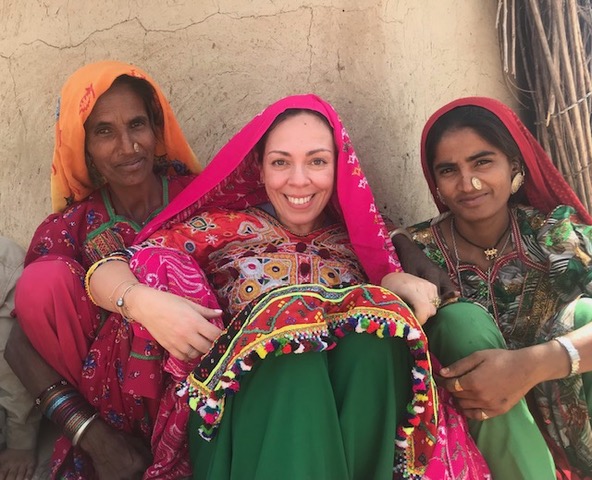Joanna Williams is a Creative Consultant from Los Angeles, who sources Textiles & Rarities from Around the World on her travels. She founded the Kneeland. co, a design concept studio and inspiration resource through which she works with leading design and interior brands on textile projects. We speak with her to understand her views on Indian textiles and it’s relevance in contemporary design culture.
Read MoreHandwork Studio operates at the intersection of craft, commerce, research and design, mobilizing high levels of skill and tradition to sustain local communities while recontextualizing traditional techniques within a contemporary design aesthetic.One of our most exciting collaborations is currently underway in Assam, India, where we are working with the innovative 7Weaves, a community and ecologically focused bioregional silk initiative.
Read MoreThe universe has thrived on geometricity silently since time immemorial. We humans are made of it. We live with it and live by it. Probably that is why we get drawn to its symmetry and asymmetry even in design, fashion, art and craft. However, in contemporary clothing, we lend this concept to mostly prints and silhouettes.
Read MoreA gallery style concept store in South Kolkata homes contemporary art and crafts. Rajesh, founder of Z precinct, took us around his space and then for an architectural walk around the neighbourhood.
Read MoreI grew up with crafts. Our home, and my grandparents homes, were full of handmade handwoven Indian art and craft, even when many Indian interiors were still full of European velvet, lace and chandeliers!
Read MoreAfter many years of studying craft traditions of Kutch, and then many years working with hand embroidery artisans, I decided to begin a design education program for artisans. I felt that a new direction was needed. Crafts were appreciated enough to commercialize them, and yet the process used was to bring professional designers to "intervene."
Read Moren 1999, Mangaldas family opened their terrace to welcome guests who wanted to indulge in authentic homelike Gujarati food and call it Agashiye. Today the ancestral home where once resided the two Mangaldas families, has managed to create a luxury hotel that carefully restores their family cultural heritage and offers an experience that matches none other in the city.
Read MoreMy move to Stockholm was an eye-opening step in my life and my professional journey. Even though I have had a keen interest in writing and interior design since my teenage years, the Scandinavian lifestyle made me experience design in a new way and question our relation to local crafts. In the Nordic countries, the design industry is recognised as a cultural value, and given a more conscious approach.
Read MoreThe Gaddini arrives at the wedding, moving her head slowly, so as to not disturb the splendid, golden nose-ring. Her mahindi-covered hand holds in place the red and gold chiffon, draped over her head. Her heavily pleated, floral skirt sweeps across the floor. Wrapped around, and around, her waist is a dora, a sheep-wool rope, the most distinguishing feature of the attire of the Gaddis.
Read MoreAn artisanal and ethical brand from Sydney, hopes to bridge the gap between artisanal work and fashion by combining cultural forms of silhouette and woven textile in single garments. Badaam was founded by creative director Priyanka Kaul in 2017. Badaam's thoughtful philosophy ensures ethical production of handwoven and natural fabrics in healthy work environments.
Read MoreMuch of the contemporary aesthetic as seen in our curated objects comes from the packaging of the objects rather than changing the designs that the artisans create. I’ve chosen materials and neutral color schemes that complement the works, not detract from them.
Read MoreOur passion for Indigo dyeing led us to communities in Sindh, Pakistan where this tradition can be traced back to the ancient Indus civilization, more than 5000 years ago. Today, Indigo dyeing is still practiced along the banks of the River Indus. Our explorations started with traditional Ajrak textile patterning methods.
Read MoreGujarat, our land, our Inspiration, our Muse! Vraj:bhoomi’s roots lie in Gujarat, a prosperous state with high spirits, dynamic society and cheerful celebrations, a state with its true colors of rich heritage and cultural traditions. There is so much that the state has to offer in terms of inspiration
Read MoreRazel giggles as she pushes open another door of a wooden, stilted house. Behind the closed doors of Falam, one of the main towns in Myanmar’s remote Chin State, are dark rooms housing traditional back-strap weaving looms.
Read MoreIndia is an incredible place of diversity culturally, geographically, and artistically in terms of textiles. India has always been rich in resources for textiles and produced stunning results in this field globally for centuries now. India’s extensive history in techniques and the quality of hand done work that can be achieved are real strengths.
Read MoreTraditional wool processing techniques of ladakh are weaving and felting. Knitting was introduced by the Moravian(missionary) housewives in 1885. The ease of processing(portability, tools) and applications(socks, caps, sweaters etc.) made it popular in the region.
Read MoreThe modernization of our country has depleted a lot of traditional technology and know-how. Yet, in far flung areas, in hidden worlds, we can find some remnants of traditional crafts. One such craft is weaving textiles from wool of Gaddi sheep in Himalayan region of Dhauladhar range.
Read MoreThe term ‘boro,’ for ‘ragged’ refers to traditional Japanese textiles patched together by hand from scraps of cloth. They are stunning every time you look at them: a sea of blue cloth interjected with patterned patches of cotton – discarded in a forgotten century – worn around the edges, and dotted with stitches as if mended in haste. A result of need rather than want, boros are imprecise, the design of the whole, unspecific but thoroughly compelling.
Read More



















